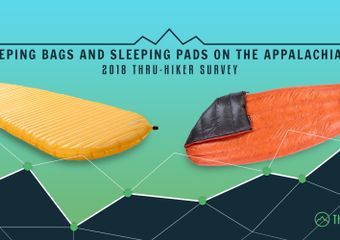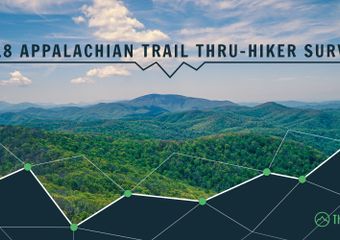Top Backpacks on the Appalachian Trail: 2018 Thru-Hiker Survey
In this installment of The Trek’s 2018 Hiker Survey, we cover backpacks and base weight. We asked hikers about the frame type, capacity, brand, and model of their backpacks.
In the past, we’ve found that the load within that pack affects hikers’ perceptions of the backpack itself, so we’ve also looked into the weight that hikers carry. Hikers this year packed a little differently than they did in previous years. For the charts and details, keep reading, or else skip to the TL;DR at the bottom.
The Hikers
Three hundred and ten hikers participated in the survey, all of whom had walked a section or thru-hike of the AT in 2018. Three-quarters were thru-hikers and the rest were section hikers. For more details on the hiker demographics, check out our post with general information from the survey.
Most hikers had done backpacking trips just a few days long before their thru-hikes. Extensive experience and complete lack of experience were both uncommon.
The Typical Backpack
Frame Type
Most hikers used internal frame packs. Frameless and external frame packs, which are typically used for ultralight backpacking, were carried by less than a fifth of hikers. The older external frame packs were used by a handful of hikers.
Capacity
Thru-hikers’ packs had an average (mean) capacity of 50.4 liters, but anything between about 44 and 60 liters was common. Thru-hiker pack capacities ranged from 30 to 80 liters.
The average capacity of section hikers’ packs was 52.6 liters, and anything from 44 to 62 liters was common. Their pack capacities ranged from 30 to 80 liters.
There was not a significant difference in pack capacity for thru-hikers compared to section hikers.1
Top Brands and Models
We asked hikers which brand and model of pack they used on the AT was their favorite. Only a handful of hikers disliked every pack they used, so that data were not included in the charts and lists below.
Overall Top Packs
Most popular standard pack
Osprey Exos (39 hikers)

Most popular ultralight pack
ULA Circuit (23 hikers)

Most popular women’s pack
Osprey Aura (30 hikers)

Top Ranked Brands and Models
1) Osprey (132 hikers)

2) ULA (43)

3) ZPacks (26)

4) Hyperlite Mountain Gear (17)

- Windrider series (8)
- Southwest series (6)
5) Granite Gear (14)

- Crown 2 (11)
6) Gossamer Gear (13)

Base Weight
Base weight refers to how much a backpack weighs when it is filled with everything except food and water. This often fluctuates during a long-distance hike, but it is more stable than total pack weight with food and water. Hikers in our survey reported the typical base weight during their 2018 AT hike.
Thru-hikers’ average base weight was 19 pounds. Base weights ranged from five pounds to 45 pounds. Notice the asterisks (*) in the graph for thru-hikers in blue. Although the average base weight was 19 pounds, it was about equally as common for thru-hikers to have 15-pound and 20-pound base weights. One hiker reported the impossible base weight of 80 pounds. It is possible this was a typo or that they were reporting kilograms, so I dropped this data from the analysis. The average base weight for section hikers was 22 pounds, with a range from eight to 45 pounds.
Furthermore, there was a small, but significant, inverse relationship between distance hiked and base weight, meaning hikers with lower base weights were more likely to have walked farther. This could be because thru-hikers “shook down” their packs more, invested more money in lighter gear, or it could be that a lower base weight helped people stick with it. This is consistent with the pattern we observed in 2016, so I would even more strongly recommend that anyone planning to thru-hike should attempt to get their base weight as low as possible, but at least 20 pounds or less.2
Problems with Weight and Capacity
Hikers who had smaller-capacity packs carried significantly lower base weights. This is a good thing, and it’s different from previous years, when even hikers with small packs were carrying loads of the same weight.
In order to get a better understanding of the role weight and pack size play in pack satisfaction, I looked at base weight and capacity as predictors of pack satisfaction, controlling for frame type, prior experience, and distance hiked.
This year, having a lower capacity pack predicted greater satisfaction, and base weight did not. This was different from what we’d found in previous years, when base weight also predicted backpack satisfaction. In combination with the fact that this is the first year of our surveys that people with smaller packs were carrying lighter loads, I’m concluding that hikers did a better job of packing appropriately for their backpack. Likewise they did a better job selecting the appropriate pack for the load they carried.3
Basically in previous years, many hikers with ultralight packs were carrying too much for that pack size, and subsequently reporting pack dissatisfaction that didn’t seem, based on my analyses, to be the backpack’s fault. This year, it appears that they packed better and were more satisfied with their backpacks.
Considering the change this year and the patterns from previous years, I continue to recommend that you should not use ultralight packs aspirationally; if you can’t maintain an ultralight load, you may be more uncomfortable from cramming too much into a less supportive, smaller space. For beginner hikers who aren’t sure what base weight they can commit to, I would recommend getting a standard pack with a removable brain (basically a smaller bag at the top that can be removed). That way, if you are able to lighten your load, you can downsize your pack at that time. Each of the most popular standard pack models ranked above (Osprey Exos and Aura) has a brain.
TL;DR
- Most thru- and section hikers use internal frame packs, but ultralight frameless and external frame packs are not uncommon.
- If you intend to thru-hike, aim for a base weight of 20 pounds or less. Many hikers manage a base weight of 15 pounds. Aim for that if you can.
- This year, hikers did a better job of packing lightly if they were using lower-capacity packs.
- Use a framed pack if your base weight is 20 pounds. or more. There’s no need to splurge on state-of-the-art ultralight gear if you aren’t actually hiking ultralight.
- If you aspire to be ultralight but don’t have much experience, get a pack with a brain and downsize when you can.
- The most popular standard pack, the Osprey Exos, has a brain, as does the most popular women’s pack, the Osprey Aura.
- The ULA Circuit continues to be ranked the most popular ultralight pack.
Muchas Gracias
Many thanks to all the hikers who participated in the survey! Congratulations for walking so far! I am grateful to Maggie Slepian and Zach Davis for their input and for distributing the survey.
More from the Annual Hiker Survey
Check out the overview post for this year’s survey, as well as the posts on footwear, sleeping bags, and shelter systems. To stay updated on the subsequent hiker survey posts, follow us on Facebook, Twitter, and sign up for the newsletter.
Notes for the nerds
- For a two-sided independent samples t-test with a 95 percent confidence interval, t = 0.236, df = 65.09, p = 0.813.
- Pearson’s r = -.11, p = .05, for the variables Distance Hiked and Average Base Weight.
- Multivariate linear regression was conducted with pack satisfaction as the outcome and base weight, distance hiked, pack capacity, frame type, and prior experience as predictors. The only significant predictor was pack capacity, b = -.018, t(284) = -2.427, p = .016. The overal model statistics were R^2 = .028, F(1, 284) = 1.665, p = 0.143.
This website contains affiliate links, which means The Trek may receive a percentage of any product or service you purchase using the links in the articles or advertisements. The buyer pays the same price as they would otherwise, and your purchase helps to support The Trek's ongoing goal to serve you quality backpacking advice and information. Thanks for your support!
To learn more, please visit the About This Site page.









Comments 13
Surprised at the lack of Gregory packs on the list especially the Diva and Beltoro models.
That’s what I used.
Those packs are great expedition and winter packs but weigh in about five pounds.
I have section hiked with one but now use an Osprey. I’m happier with it.
Now if I were winter camping and doing a week or less I’d switch to the baltero in a heartbeat.
In your section, “Base Weight”, you mention:
“Notice the asterisks (*) in the graph for thru-hikers in blue. Although the average base weight was 19 pounds, it was about equally as common for thru-hikers to have 15-pound and 20-pound base weights.”
However, your chart has blue being for SECTION hikers. Is the graph incorrect or your analysis?
This discrepancy between color/label in the charts is also might also be present in the capacity chart/analysis.
Overall, a wonderful piece of analysis for those of us planning on going thru with it soon. Thank you!
Thanks for posting! Did hikers self-report base weight? I wonder if there is a skewing effect because hikers (1) under (or over) estimate their base weights, and/or (2) report a number that they think sounds better. I’ve noticed a lot of gear lists don’t include the little ticky-tacky stuff (stuff sacks, tweezers, charger cords) that I suspect start to add up. It reminds me of counting the calories in a salad but leaving out the dressing… that’s the heaviest part!
If they were reporting in kg, that would be even more impressive/impossible!
Keep the new Granite Gear Blaze 60 in your radar following its 2019 spring release. Designed for thru-hikers, this pack will a load capacity of 50 pounds just for starters and an amazing list of features that are ensured to make this a great choice for any long or extended trek or section hike.
@Tim Brown. The extra weight capacity of the Blaze 60 sounds interesting. I have the current model, plus the top lid. My problem isn’t with the weight carrying capability but the volume. Since my wife has a double-spinal fusion and limited by how much she is supposed to carry, I carry all our shared gear. That means the tent, cook system, water filter, DeLorme InReach device, siltarp for bad weather dining, and potentially her sleep pad goes in my pack. I’ve done that for 6 day trips using the Blaze AC60, but it can be challenging.
What I wouldn’t give for another 5 liters or so.
Thank you for these.
The data is such a valuable check on the anecdotal stories out there.
Thank you.
Nicely written…well done!
Just a brief comment…the Osprey Exos (most popular standard pack) and the Ula Circuit (most popular ultralight) are basically the same weights…42oz vs 41oz
But I’m pretty sure that that Appalachian trail hikers back in the 1800’s hiked the trail with their trusty rifle strapped to their back.
https://www.writemyessay24h.net/
Did any REI packs show up in the survey? Not surprised that Osprey is leading the pack but the competition is catching up. Great list!